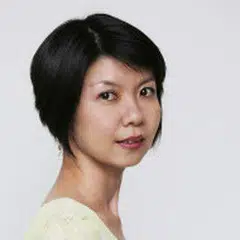Young Singaporeans injecting new life into Chinese temple culture
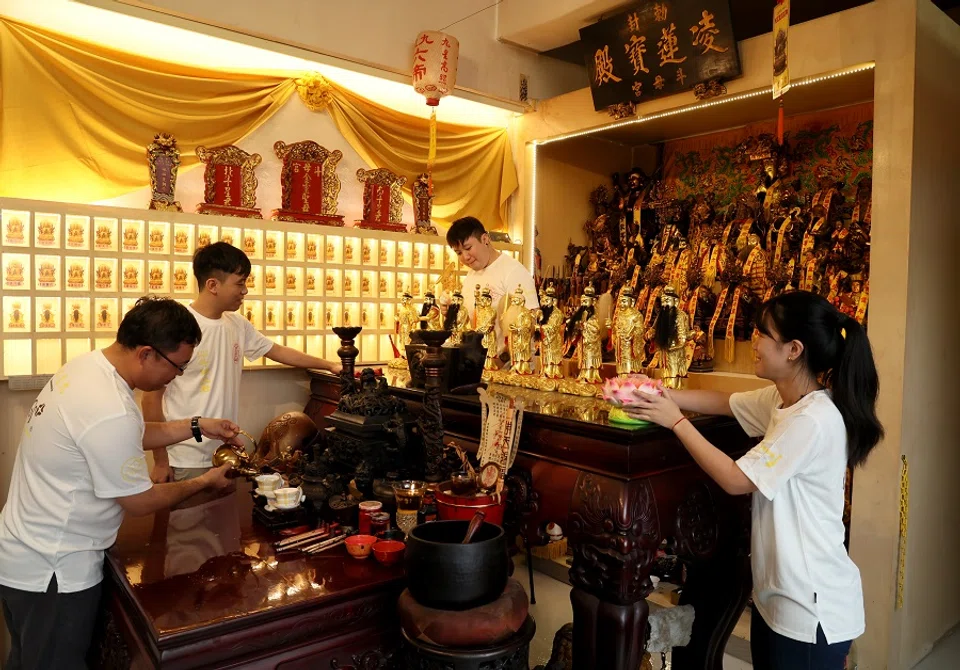
(Photos: SPH Media)
Singapore may be a small state, but it's home to more than a thousand temples big and small. More than just religious sites, these temples served as meeting places and spiritual sustenance for our forefathers from China.
According to Singapore's Census 2020, 8.8% of residents aged 15 years and over are Taoists. But as times change, temple-goers, whether volunteers or worshippers, are ageing.
Still, the Chinese traditional idea of "respecting heaven and earth, honouring the gods and worshipping ancestors" has been passed down from generation to generation, and has unconsciously taken root in the hearts of some.
Youths on mission
The doors of a corner unit in Tampines Industrial Park are usually locked on weekdays. But come the weekend, joyful chatter can be heard within. Worshippers offer incense while volunteers tidy up the place or have a meal. This is Ling Lian Bao Dian Kew Ong Yah (LLBDKOY 凌莲宝殿斗母宫), a small but lively Taoist temple in Singapore.
This factory unit is in fact the temple's second life, after it was saved and restored by a group of young people.

In December 2020, the 60-year lease of 191 private terrace houses at Lorong 3 Geylang expired. Most of the 16 temples among the affected units were forced to close or relocate. The manager of LLBDKOY, Chia Choon Chye, is in the renovation industry and acquainted with interior design firm owners Louis Tan Ching Liang, 31, and Issac Thong, 30. Tan and Thong, both regular worshippers at LLBDKOY since 2018, decided to take action after hearing of the temple's plight.
Tan said the temple had already been looking for solutions after it got the news to relocate. But it found itself in a desperate situation when the government issued a final notice in November 2020 to move out within a month. He told Zaobao, "We initially wrote to the MP [Member of Parliament] for Geylang, but no specific assistance was given. Since I live in Sembawang and because we were so pressed for time, I had no choice but to write to Ong Ye Kung, the MP for Sembawang. Thankfully, he responded very quickly."
Initially a temple operating from a residential unit, LLBDKOY registered as a society after heeding the MP's advice. In less than a month, the temple found its current factory unit with affordable rent. Using their professional know-how and business contacts, Tan and Thong kept renovation costs to a minimum and roped in worshippers and friends to clean the premises and give it a fresh coat of paint.

In early 2021, LLBDKOY relocated to its current address.
Three generations of temple-goers
Sisters Doris Teo, 66, and Josephine Teo, 62, along with over ten of their family members were elated at the news. They are long-time worshippers of LLBDKOY, helping out every second and sixteenth day of the lunar month and offering incense regularly.
Doris said, "We're not sure of the temple's history but we've been worshipping there for decades. Previously, the Nine Emperor Gods Festival would be held at the open-air car park near Ang Mo Kio Ave 10, and the Nine Emperor Gods would be welcomed at the Kallang Basin later. Back then, we had to charter eight to nine buses, so you can imagine just how many believers there were. Later when the temple moved, quite a number of worshippers left. But I believe that our numbers will grow in the future."
Now that the temple has relocated to Tampines, Josephine would head to the temple after sending her grandchildren to school. She would tidy the place and refill the oil in the lamps, spending around two hours there each time.
The interaction between three generations of temple-goers was really heartwarming to see.
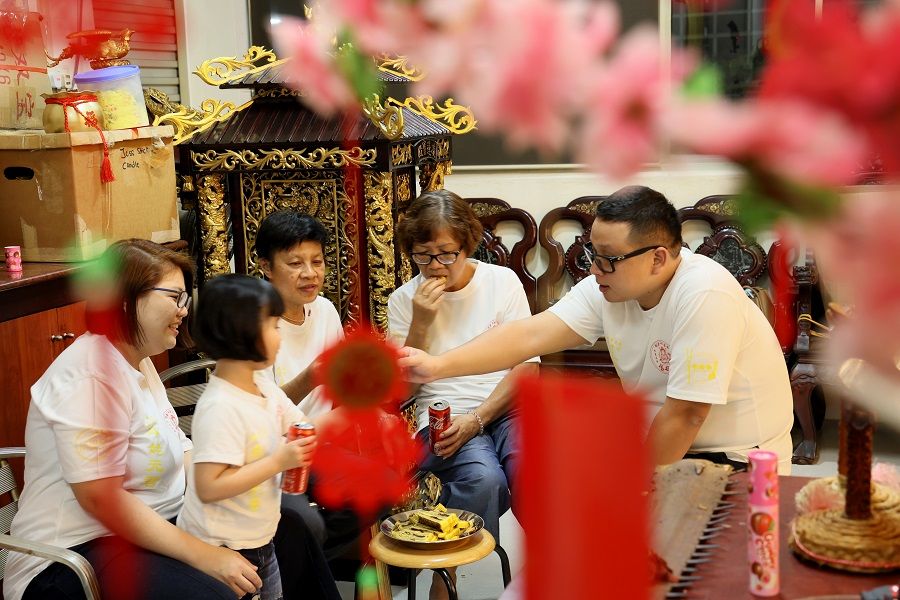
On the day we met for the interview, the Teo sisters' niece Jane Lui, 34, and Lui's husband, Dai Jun Xian, were also present. The couple's six-year-old daughter, Jalista Dai, was comfortably chatting and moving around the adults. The interaction between three generations of temple-goers was really heartwarming to see.
Lui, a hospital administrator, started visiting the temple with her elders when she was around ten years old, while her husband learnt of LLBDKOY when they were dating. They think that everything fell into place very naturally, and they are even on the temple's board of directors now. Their friends and colleagues do not find their active involvement in temple affairs strange and would even help out when the temple needs to pack hampers for charity events.
Due to regulations of the factory unit, the temple is not open to the public; its board of directors and worshippers usually only gather there on weekends or during festivals. They would have some fellowship over food and have had hotpot and barbeque gatherings too.
... why did this group of young people choose to spend their free time shouldering the burdens of a temple's fate instead of watching movies and having fun?
New blood, new style
The Teo sisters call the group of young board members led by Tan their "benefactors" not only because they gave the deity idols a resting place but also because they gave worshippers a place to pray. This got me curious: why did this group of young people choose to spend their free time shouldering the burdens of a temple's fate instead of watching movies and having fun?
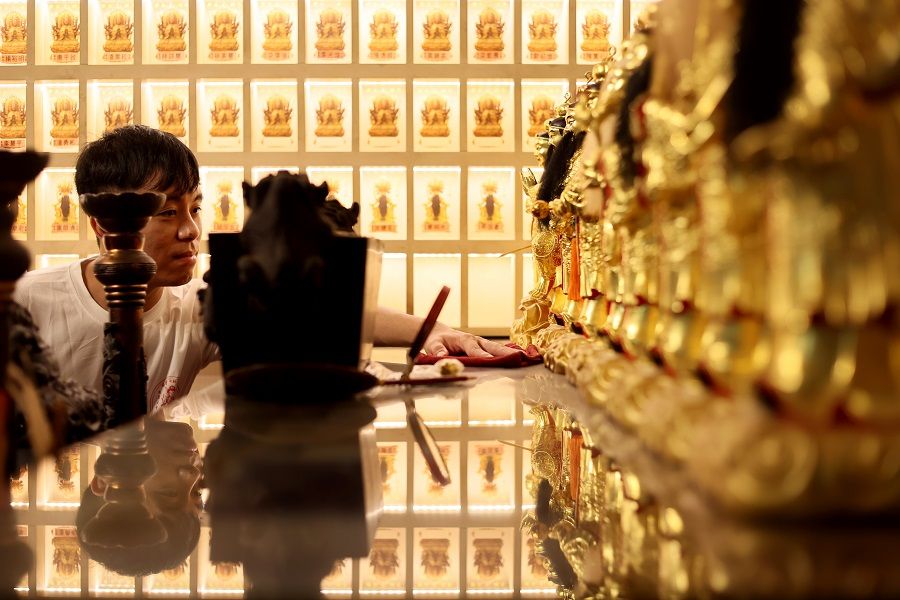
Among the 22 members of the 2023-2024 LLBDKOY board of directors led by chairman Louis Tan, half are young people. He laughed, "It's not so serious and solemn! There is still a group of older and more experienced people around, so we'd follow their lead when it comes to rituals and festivals, which makes it more manageable. We just try to do more of the operational and administrative work that we are better at."
To improve the management structure of LLBDKOY, Tan and his team personally invited lawyer Ellen Lee Geck Hoon to serve as the temple's legal consultant. MP for Tampines Baey Yam Keng also accepted their invitation as a guest-of-honour and has been participating in the Nine Emperor Gods Festival at Pasir Ris Park for two consecutive years.
Doing something for the temple is our way of helping to keep the roots of Chinese traditional culture alive. - Issac Thong
The young board of directors have been thinking of ways to connect the temple with the outside world. Over the past two years, it has been distributing hampers to the underprivileged living in Tampines, giving out a total of 150 hampers in 2021 and twice the number in 2022. This year, the board of directors plans to organise a care banquet on 28 October, inviting the elderly to a restaurant for dinner and karaoke, bringing warmth to them.

Everything from the temple's daily expenses to the funds needed for its activities are paid out of the directors' own pockets. Thong said, "Distributing hampers and organising the care banquet are ways in which we give back to society. Doing something for the temple is our way of helping to keep the roots of Chinese traditional culture alive. Although there are other Kew Ong Yah temples and Tao Bu Keng temples around Singapore, most of its directors are older people. We hope that this folk religion can be preserved and passed down."
Energy and effort in exchange for abundance of heart and soul
Our photojournalist joked that it was his first time visiting a temple with air conditioning. Indeed, this temple is rather different - it neither has the solemn air of temples nor is it filled with thick incense smoke. Young board members take close-up shots of the deity idols with their phones while bantering with one another; friendly-looking elders join in the discussion and are very hands-on when there are things to be done. Because the congregation is like a big family, the cohesive energy pulls them together to spend time at the temple. Other temples lamenting the lack of successors can learn a thing or two from this temple.
If there's something to be gained, it's the blessings of the gods on each of their lives - that their paths may be smooth and peaceful and they'd have a smile on their face. But what these young board members experience most concretely is a nourishment of the spirit and the mind, and a sense of satisfaction from successfully organising events with limited resources time after time.
Interior designer turned temple craftsman
Growing up in an environment surrounded by temples and Buddhist halls, a love for sculpting and painting deity idols has long been planted in the heart of 48-year-old Andy Yeo. But never did he imagine that he would switch careers one day, giving up his interior designer job to work as a temple craftsman. In the eyes of friends and family, this was a strange choice, but Yeo willingly embarked on this lonely path.
Not far away from his childhood home on 4 Nankin Street sat Poh Tiong Tian (普忠殿, predecessor of Poh Tiong Beo (普忠庙) in Toa Payoh), a shine where his grandfather and father often helped out at. Yeo started visiting it when he was in primary three or four, and was immediately awestruck by the vivid expressions of the deity idols and the vibrant wall paintings.
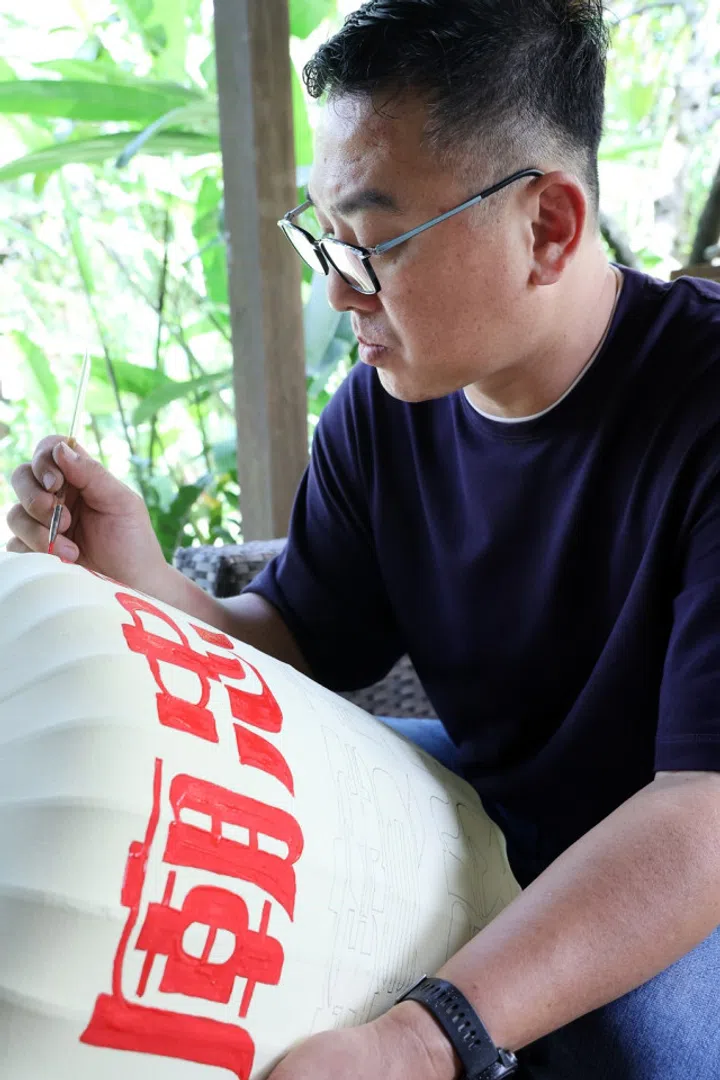
He said, "It was always bustling with activity, with events large and small. Often, people put up tents for temple celebrations and I was always attracted to the deity idols, lion dance heads and dragon dance heads. When I grew up, when I saw idols that were once new now damaged and broken, I wondered: 'Could they be fixed?'"
Learning from a Tainan master craftsman
Although Yeo tried to learn the craft, most local craftsmen preferred to keep their knowledge to themselves, which put Yeo's passion on hold.
It was not until he went on a business trip in 2002 to Tainan in Taiwan that things changed for him. As Yeo's accommodation was right next to a temple, he would walk past a master craftsman carving deity idols every day. After chatting with the teacher over meals and getting better acquainted, Yeo boldly asked if he could learn the craft from him. Subsequently, he kept learning his craft from videos after buying some materials and pigments to work with.
In 2017, a pair of six-feet-tall idols at the Poh Chung Tian Chor Sian Tong temple in Toa Payoh (formerly the above-mentioned Poh Tiong Beo) became heavily infested with termites. Local craftsmen asked for S$40,000 (US$29,600) to restore them. Yeo boldly volunteered himself as an alternative, asking the board of directors to give him two years to restore the idols.
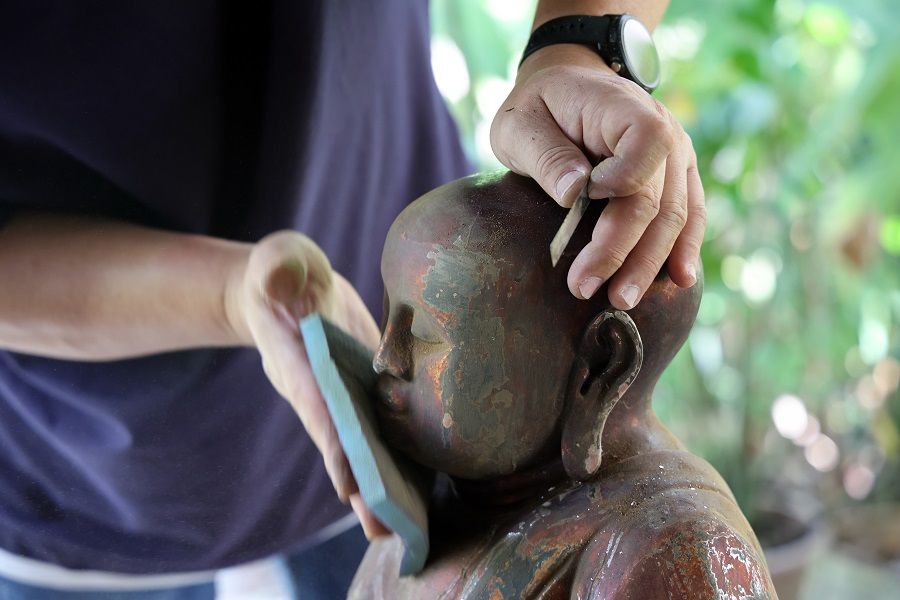
He said, "I pitched a small tent behind the temple and worked on the idols bit by bit every weekend. I finally restored them after one and a half years. Just like that, a fire was reignited in me!" After this, he tried restoring some simple idols and began accepting some small projects to work on. Last year, he officially registered his own studio: "a²+rt Studio".
The feathers move slightly in a breeze, and the Monkey God seems more alive. This is his favourite piece, and he has not sold it, even though he has received generous offers for it.
Restoring with respect
Yeo says he is not yet a master at his craft, and is willing to learn. Initially, he "practiced" on figurines sent to the temple. He said: "Many people send their figurines to the temple when they no longer pray to them. I asked the deities in the temple whether they would let me restore them, and their instructions were that I had to do it respectfully, and not throw them aside if I could not restore them."

One abandoned figurine of the Monkey God was a rare first-rate work by the well-known Cai family's lacquer thread sculpture in Xiamen. Yeo first removed the layer of dust, then restored the original colours. The two long feathers on the Monkey God's headgear are easily damaged and many craftsmen would restore them with metal wires, but Yeo felt that would be too stiff, and put in effort to find peacock feathers instead. The feathers move slightly in a breeze, and the Monkey God seems more alive. This is his favourite piece, and he has not sold it, even though he has received generous offers for it.
Yeo treats each figurine with care. After each restoration, he writes down the name of the deity and the date of the restoration in both seal script and official script on the fingers of the deity.
Subsequently, he also tried restoring some larger items such as lanterns, gold furnaces or incense burners, door figurines, wooden figures and sedan chairs for the deities. He said with feeling: "Few craftsmen in Singapore do such work. Some stores send the items to China or Malaysia where they might use machines and spray paint for the restoration. They also like to use shinier colours, which might be more eye-catching, but I feel religious figurines should look more dignified."
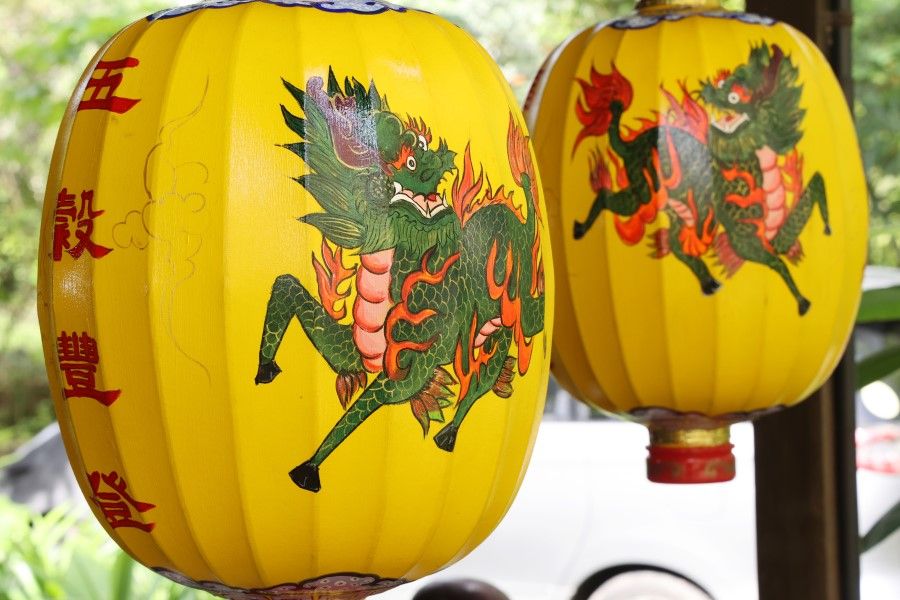
Yeo is still finding his own style. A pair of Fujian-style lanterns that he just finished restoring carries a lot of personal style. Most lanterns have peonies or finger citron flowers (佛手花, lit. Buddha's hand flower) drawn on the top or bottom, but he took reference from lanterns in Taiwan and other places, and used Chinese knotting patterns, while boldly using purple and indigo instead of the usual red and green. He also opted to use newer fonts to give them a more vibrant feel.
Growing lacquer thread porcelain works
In the course of his restoration work, Yeo has found that the lacquer thread on some figurines are badly faded, and he hopes to master this traditional craft. Late last year, he went to Kaohsiung in Taiwan to join a basic course by lacquer thread sculpting master Lim Kah Ghee.
Lacquer thread sculpting originated in Quanzhou, Fujian province, and is used to decorate figurines to show elegance and liveliness through intricate lacquer threads. After the course, he even bought a set of machines and supplies that are not available in Singapore to continue practising the craft.
He said: "The instructor told us that if we only focus on traditional culture, we will not be able to make a living. We have to adapt, such as integrating modern elements, to raise traditional works to another level while preserving traditional craftsmanship."
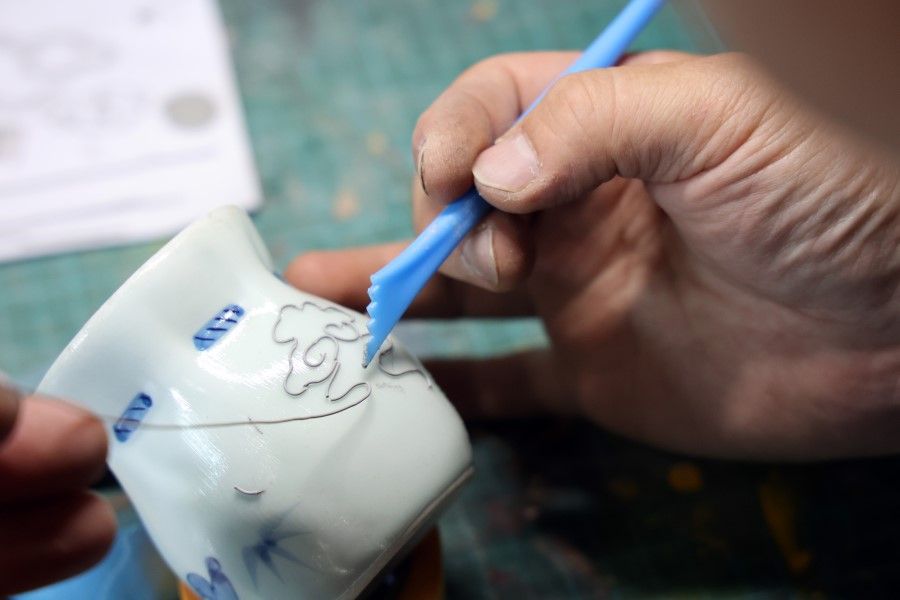
So, Yeo persuaded some ceramic artists to add lacquer thread to their ceramic works. He got the idea from how leaders in mainland China and Taiwan gift lacquer thread items to guests - Yeo hopes that one day, Singapore-style lacquer thread crafts will also make it to a larger stage.
"The closure of lantern makers Yeo Swee Huat Paper Agency and joss stick makers Tay Guan Heng last year was quite demoralising." - Andy Yeo
Hopes for government support of traditional crafts
Yeo rents half a workshop space in a ceramic workshop at Jalan Bahar in Lorong Tawas, in Jurong West, where rental is more affordable, and is often worried about when the government might take back the workshop space.
Yeo said: "For us in the creative industry, it is not like running a supermarket, where people come in to buy stuff every day. Sometimes, I restore just one item in a week. Other times, many items come in at once. The income is unstable but there are always expenses; rental is the biggest burden. Hopefully, the relevant agency can help us who are in traditional arts to keep going. I wouldn't say I'm a noble defender of Singapore culture, but if these traditional arts disappear, they can only be imported from overseas and the local characteristics and origins would be lost. The closure of lantern makers Yeo Swee Huat Paper Agency and joss stick makers Tay Guan Heng last year was quite demoralising."

Yeo's current income is a lot less than when he was running an interior design company, but he has no regrets, and even hopes to wrap up the remaining interior design projects on hand this year and focus fully on religious and cultural crafts.
Young collector of figurines and academic research
While other people were obsessing over superstars, Dean Wang, 35, was collecting religious figurines.
I had thought Wang's home, which he shares with his wife and daughter, would be filled with religious items, but there were just ordinary furnishings. He took me to his study, where there were over 20 religious figurines on a table by the wall. This was just part of his collection - he had collected two or three hundred figurines over more than 20 years, some of which are with his father.
"Deities are connected to opera. Quite a few evolved from historical figures, so deities touch on many levels, including opera, art and painting and so on." - Dean Wang

When he was in primary six, in a religious store in Taiwan while on a family trip to mainland China, Hong Kong and Taiwan, Wang saw a new figurine of a lord deity (王爷) carved out of sandalwood from the Laoshan area, and bought it as a souvenir as it caught his interest.
He said, "I used to go for tuition around Waterloo Street, and there was a market nearby selling religious figures, so I saw how the market operated and what kind of figurines were sold. Sometimes I saw some that were unique, and asked my parents which deity it was. Since I was a kid, I liked the smell of wood, so I would look for wood-carved figurines. I am also interested in Chinese culture, and deities are connected to opera. Quite a few evolved from historical figures, so deities touch on many levels, including opera, art and painting and so on."
Wang's curiosity and interest in folk beliefs and Chinese culture led him to develop a hobby of collecting after owning his first idol. He could not really identify the deities initially, and had to ask his elders and friends to find out which ones were more worth collecting.
As a child, Wang bought figurines with his pocket money. Later, as he learned more, he collected them through various channels. Now, with the internet, it is even more convenient. He is also in contact with fellow aficionados in mainland China, Hong Kong and Taiwan through social media and private chat groups, and finds that many people get rid of old figurines when they are no longer used for prayers - when someone puts up a post, he goes to see if he can take some in.
Fondness for figurines of Lady Linshui and lord deities
When he was a student in the Chinese faculty at the National University of Singapore, Wang was especially interested in Chinese traditional culture and temples, and even researched a lost village or kampung in Bukit Brown (Kopi Sua, lit. Coffee Hill in Hokkien), where the residents mainly followed the three lords or deities Zhu, Xing and Li.
His first postgraduate academic thesis was on a Taoist priestess, born Chen Jing (陈靖) and called Chen Jinggu (陈靖姑). When she was 24, Chen Jinggu prayed for rain amid a drought even though she was pregnant, and ended up sacrificing herself and her unborn child for the people, who deified her as Lady Linshui (临水夫人), the goddess of childbirth. With this, Wang later had a particular liking for figurines of lord deities and Lady Linshui.
"Not looking pretty, but a fundamental beauty, that feeling that comes from every single cut executed by the carver over time." - Dean Wang
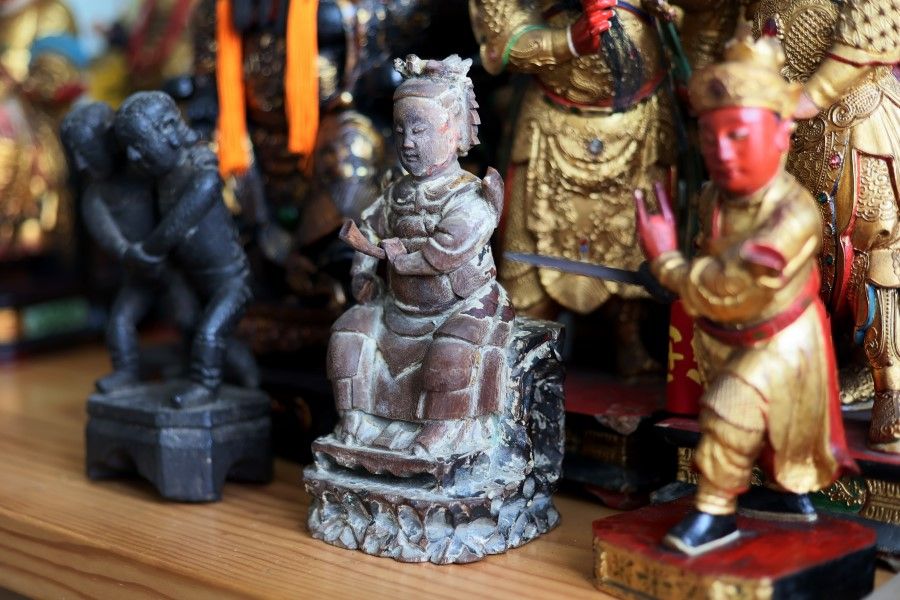
When choosing items to collect, he would go for older artefacts and those that are not mass-produced by machines - one is after one-of-a-kind handmade figurines. Those in the industry look at the wood: blade marks show that it was made by hand, while those produced by computer would have machine-bored holes.
The next thing is appearance. Wang explained: "The main thing is the feel and charm. Not looking pretty, but a fundamental beauty, that feeling that comes from every single cut executed by the carver over time. The facial expression is the most important. To use an everyday analogy, it's like finding a boyfriend or girlfriend; if the first impression is pleasing, then we look at the overall form of the figurine. If it is not pleasing, it does not matter how expensive or well executed it is."
The materials themselves can appreciate in value. Sandalwood from Laoshan is less common; camphor is generally used for its bug-resistant properties. Taiwanese favour small-leaf or stout camphor, which is of a higher grade than ordinary camphor wood. There are also many different carving styles - for instance, the "stacked dragon scales" technique involves preparing groups of "dragon scales" before sticking them on the lacquer thread figurines, which is very time-consuming. Some figurines might feature unique drawing techniques or materials, such as being coloured using minerals like cinnabar or jade powder.
With their rich experience, just by looking at the back view or a part of the figurine, those in the industry can tell which deity it is. Currently, Wang prefers figurines in their original form and as far as possible avoids restoring them, only applying minor touch-ups to those with more severe damage.
From wooden figurines to talisman boards from big temples
Wang opens a round hole in the back of a figurine of the Baosheng Emperor (保生大帝, lit. Protector of Life), a deity of medicine. From the little opening, he takes out a small note, on which is written in brush calligraphy the 20th year of the reign of the Qianlong Emperor - 1755AD, 268 years ago.
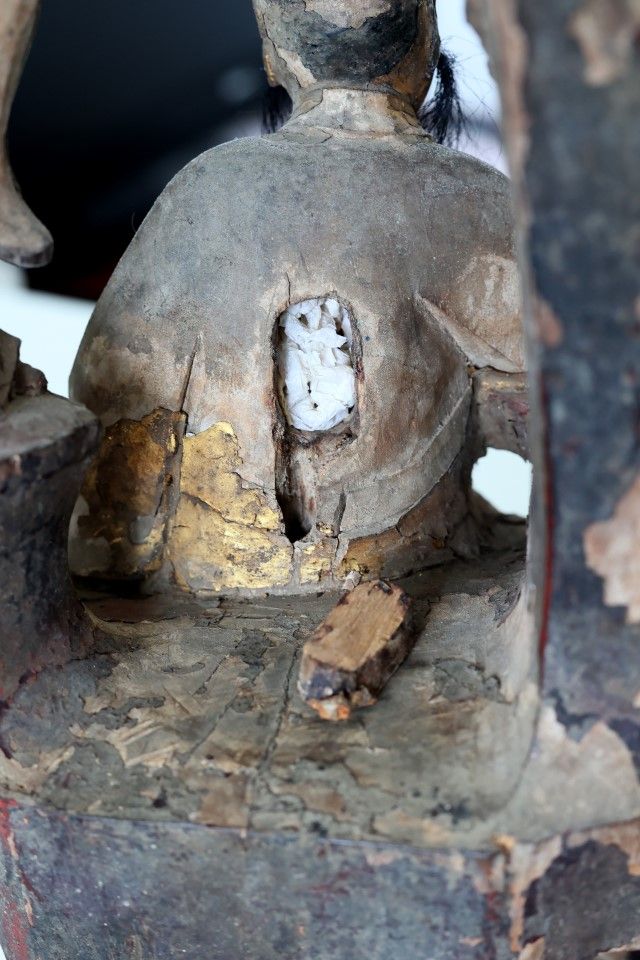

It turns out that a figurine, even when finished, is just an ordinary figurine until a ceremony is held to "awaken" it or make it sacred. A hole known as a "deity hole" (入神孔, lit. "deity entry hole") is made in its back, and symbolic items such as incense ashes, talismans, five-colour thread and five grains/cereals (which are seen as sacred gifts from the gods) are placed inside and sealed up to symbolise bringing the figurine to life, just as humans have various organs in the body. The note I saw was a "certificate of origin", like an identification of sorts for the figurine, bearing the year of "awakening", the name of the deity and the region of worship, and what to pray for.
In recent years, Wang has also started collecting talisman boards, of which he currently has about 20. He shows me a piece from Quanzhou in Fujian featuring the Baosheng Emperor. "Generally, only big temples would carve such talisman boards featuring deities, it is rare to see such a big one. After such boards are completed, believers can take them home, and seeing the item is like seeing the deity. Small temples generally only carve words or symbols. Interestingly, the seller took this from Singapore to China, and then I brought it over again from China."

Antique shops might know the buying and selling price of the figurines, but few in Singapore can integrate it with academic research like Wang. Each item in his collection ranges from hundreds to tens of thousands of dollars, but he does not feel it can be a full-time occupation. He describes it as his interest, like collecting branded bags. But Wang does hope to spread the culture and knowledge of religious figurines, such as organising sharing sessions or even exhibitions, to allow people to appreciate them from an artistic perspective.
It is indeed fascinating to see how colourful paintings or exquisitely carved idols can evoke the deepest admiration in the souls of this new generation of practitioners and collectors, as they navigate their faith, interests, jobs and life, each passing on local temple culture in their own way.
This article was first published in Lianhe Zaobao as "庙宇文化 有缘人续香火".
Related: Chinese spirituality [Part one]: Reawakening of the heart after trauma | Chinese spirituality [Part two]: The sacred is in the mundane | Ghost Festival: When the wall between the living and the dead crumbles | The Chinese ghost stories we tell ourselves | Cultural historian: Why do civilisations pass down their cultures?
